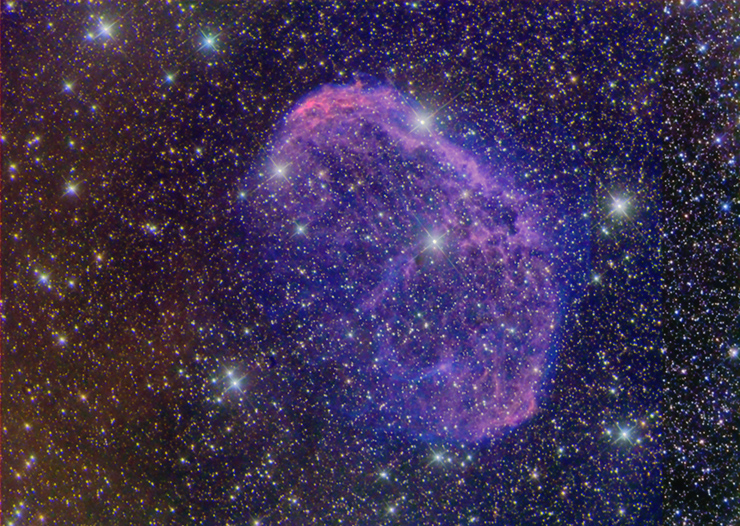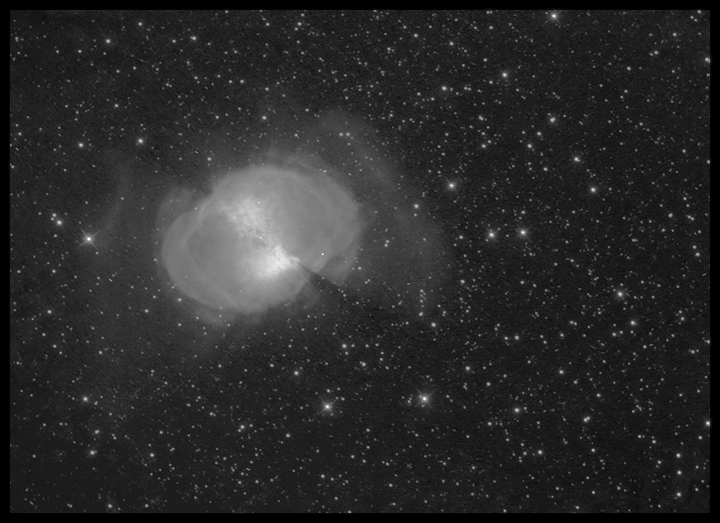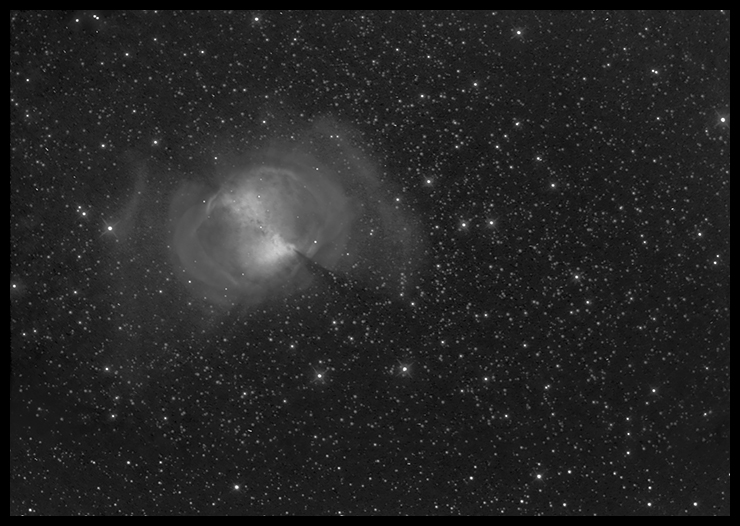09/06/2013. Picking up where we left off almost three months ago, the AT10RC didn't even need to be refocused. I'd removed the CCD and drive electronics weeks ago, when the rain and clouds became almost constant. The first weak cold front of autumn produced a few clear hours earlier in the week; a better one moved the clouds out last night. I want to try the Baader O-III filter on the Crescent Nebula, but first I wanted a decent LRGB foundation for the expected narrowband data:

NGC 6888
32x150s L, 1x300s RGB
AT10RC @ F4.8
(Orientation 188°)
09/07/2013. I had a serious disagreement with the CCD about the density of the Baader O-III filter. I was under the (evidently mistaken) impression that it would require significantly shorter exposures than the Baader 7nm H-a filter. [On reflection: this is human chauvenism. I can see through the O-III filter much more easily than through the H-a filter, but that's mostly because human eyes are relatively sensitive and insensitive at the respective wavelengths. It's still a narrow band filter and the flux reaching the chip is dramatically reduced. D'uh.] I intended to use it more or less like the broadband color filters (RG&B), but no: 300s exposures were very dark and the guider had to squint to make out last night's guide star even with 30s integrations. I changed to 900s exposures and found a much brighter guide star just outside yesterday's guide field (guiding was solid with the longish integrations, but I backed off to 20s anyway which still gives me 5,000 ecu's, enough to peer through some moderate haze if it comes). The resulting images are still much dimmer than I expected, but they're going to work out -- if the weather holds. Check back in bit.
The sky is hazier than last night's, and it's of variable transparency. I threw away half the luminance data from last night because of haze and will likely have to do a data filet of tonight's O-III take as well.
Here's three hours of O-III replacing the blue channel in the image shown above, saturations and levels adjusted to keep the stars more or less unchanged. So all that's different is that doubly ionized oxygen is made visible:

NGC 6888
150s Lx32, 300s RG, 12x900s O-III used as B
"That's mauve out there."
So what we've got is this high speed stellar wind from the exposed core of the Wolf-Rayet star slamming into the interstellar medium. The wind, I'm guessing, is mostly hydrogen, and there's a significant amount of oxygen in the medium; the former strikes the latter hard enough to compress it and a thin shell of this compressed interstellar gas glows with the light of doubly ionized oxygen. That's my story and I'm sticking with it. (Popularized astrophysics has its lingo, its own set of cliches: the stellar wind from Wolf-Rayet stars is usually "fierce" and it always "slams" into the surrounding gas. As you were.)
One nice thing confirmed: you can indeed do a good job resetting the CCD's orientation using that degree scale I wrapped around the 2-inch adapter behind the R-C. I'll eventually work out how to use S/W to do an exact alignment (if I include an L frame in the stack for alignment purposes, then delete it before combining the frames...).
09/09/2013. Dang! Must remember to change the desiccant in the CCD camera. Night before last, I had frosting issues which went away after a couple of hours. I meant to change the Particle Wave Technologies desiccant pack the next morning. Forgot. Tonight, while shooting fresh flats, I again saw strong evidence of frosting on the CCD. I raised the temperature to +5°C and let it rest there during twilight. When M27, my first target for the night, becomes available to the telescope, I'll drop the chip to working temp and hope for the best. Here's a work in progress (eleven 900s exposures in the can, more to come):

M27
11 x 900s, Baader O-III filter
ST2000XM, -20°C
There's M27 in the light of doubly ionized oxygen, imaged through quite hazy skies on a chip plagued by frost. See the starless regions in lower left and upper right? Ice. I've cropped out a substantial part of the margins (and downsampled for the web, of course). First thing tomorrow, I'll change the desiccant in the camera. Now, in the wee hours of the night, the chip is behaving better, so I'll have the 'scope collect more subframes while I get some sleep. It might all stack into a reasonably complete frame if the sky gets no worse. (Alas, it did. Clouds moved in after 4h30m of exposure; see results down below.) Tomorrow night, skies willing, I'll see about adding some fresh RGB.

M27
18 x 900s, Baader O-III filter
ST2000XM, -20°C
Not a lot of difference between 2h45m and 4h30m of exposure, eh? Maybe next time.
Let's defrost the camera and wait for clearer skies.
9/10/2013. I recharged the desiccant chamber at about 11 AM. Eight and a half hours later, there's still a lot of moisture / frost / ice to contend with. I'm playing with the chip temperature (cycling it from +5 to -10 and hoping the fan will do its thing. The sky is not particularly promising tonight, but I'd like to be confident that the chip is ready when the sky is. Particle Wave's instruction sheet says it may take 2-3 days to dry out completely, and I beleive it took about 24 hours the last time my camera frosted. So, come here often?
At 12 hours, the chip was mostly clear. An hour later, completely so. The sky improved just after twilight then started a long, slow decline. I added to last night's data pile in O-III, filling in the ice-blocked areas and increasing S/N in the interesting parts. Fog moved in about 2:45 AM and put and end to that. Here's both nights' data, a 6h 45m exposure:

M27
27x900s, O-III
The improvement may not be dramatic in these smallish, 8-bit web versions, but the difference in the full-res, full-depth images is real. Hint: do a "view image" command in your browser to see this without the bright page background. It matters in this case. You might notice a dark relatively starless void below and left of the nebula; remnant of yesterday's ice, I think. Clouds are in the forecast, and the Moon is growing. Those who say they know say I can probably get RGB data on Saturday night. I'll sneak some in sooner if I can. At worst, there's old RGB filed away, but I dont think it covers enough of this field.
Got your color data. See next page!
Except where noted, deep-sky photos are made with an SBIG ST2000XM CCD behind a 10-inch Astro-Tech Ritchey-Chretien carried on an Astro-Physics Mach1GTO. The CCD is equipped with Baader LRGB and 7nm H-a filters. The internal guide chip of the CCD most often keeps the OTA pointed in the right direction (I'll let you know when a Meade DSI and a separate OAG or guidescope takes its place). Camera control and guiding are handled by Maxim DL 5.12. The stock focuser on the AT10RC has been augmented with Robofocus 3.0.9 using adapters turned on the lathe downstairs. Maxim performs image calibration, alignment, and stacking; Photoshop CS4 and FocusMagic 3.0.2 take it from there. Gradient Xterminator by Russell Croman and Astronomy Tools by Noel Carboni see their share of work, too. Beginning in May 2013, PixInsight has taken over some of the heavy lifting for transfer function modification and deconvolution.
:: top ::